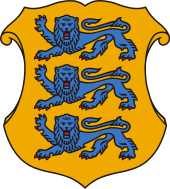List of wars involving Estonia
Below is a list of military conflicts in which Estonians participated on a larger scale or took place on Estonian territory. Items in bold are the wars most often considered to be major conflicts by Estonian historians and the general public.
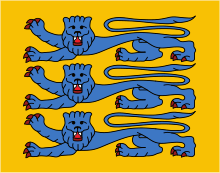 |
| Command and leadership |
|---|
|
| Services |
| Equipment |
|
| Ranks and insignia |
|
| History and modernization |
Ancient Estonia
- 6th century – 1203, a series of Estonian (mostly Oeselian) raids and counter-raids against the Swedish, Danish, Norwegian and Icelandic vikings:
- 6th century, Gotland Viking attempt to colonize Hiiumaa Island;
- 7th century, attempted Swedish invasion of Estonia by King Ingvar;
- 8th century, Swedish raid to Estonia by King Anund;
- 8th century, Battle of Brávellir, on the side of the Swedes, against the Danes;
- 972, a battle against Icelandic Vikings on Saaremaa Island;
- 1008, a battle against Norwegian Vikings on Saaremaa Island;
- 1170, a naval battle between Estonians, its allies and Denmark near Öland Island;
- 1187, Estonians (or Karelians or Curonians) raid of Mälaren and Sigtuna in Sweden;[1]
- 1203, Estonian raid to Danish Scania;
- 1203, a naval battle between Estonians and German settlers of Riga near Visby, Gotland.
- 1003–1217, a series of battles and (raid) campaigns against Kievan Rus', Novgorod and Pskov:
- 1030, Kievan Rus' defeat Chuds and establish Yuryev stronghold;[2]
- 1032, according to one hypothesis, battle at Iron Gate mentioned in Russian chronicles and usually placed in norther Russia, may have been naval battle, where Novgorod fleet was defeated near Aegna;[3]
- 1060, Kievan Rus' campaign against Sosols (tribe in Estonia) and taxation of them.[3]
- 1061, Sosols uprise, destroy Yuryev and attack Pskov.[3]
- 1113, a battle against Kievan Rus', possibly in modern Izborsk;
- 1116, Kievan Rus' conquest of Otepää stronghold;
- 1132, a battle against Novgorod in Vaiga County;
- 1134, a battle against Novgorod for Tarbatu (Yuryev) stronghold;
- 1177, Estonian raid of Pskov;
- 1192, Novgorod raid of Tarbatu (Yuryev) stronghold;
- 1192, Novgorod raid of Otepää stronghold.
- 1210–1227, raids during the Livonian Crusade:
- 1213–1219, Lithuanian raids against Estonians;
- 1213, Lithuanian raid to Sakala County;
- 1219, Lithuanian raid to Saaremaa Island and mainland Estonia;
The Middle Ages


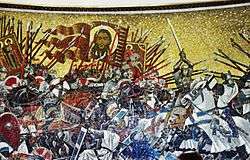
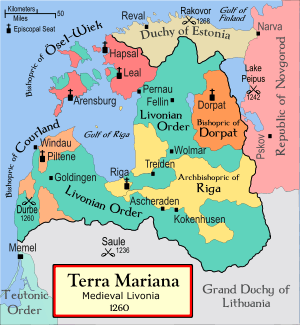
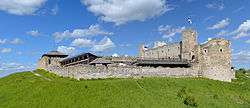
Estonia remained one of the last corners of medieval Europe to be Christianized. In 1193 Pope Celestine III called for a crusade against pagans in Northern Europe. The Northern Crusades from Northern Germany established the stronghold of Riga. With the help of the newly converted local tribes of Livs and Letts, the crusaders initiated raids into part of what is present-day Estonia in 1206.
- 1206–1268, Northern Crusades (1147–13th century/16th century):
- 1206–1261, the Livonian Crusade (1198–1290):
- 1206, 1st Danish attempt to conquer Saaremaa Island;
- 1208–1227, Livonian Brothers of the Sword and allied Conquest of Estonia;
- 1210–1224, Estonian counter campaigns against the Livonian Brothers of the Sword;
- 1217–1223, occasional Estonian-allied Pskov's and Novgorod's battles against the crusaders;
- 1219–1224, Danish Conquest of Northern Estonia;
- 1220, Battle of Lihula, against Sweden;
- 1222, 2nd Danish attempt to conquer Saaremaa Island;
- 1225–1238, a conflict between Denmark and the Livonian Brothers of the Sword, later the Livonian Order;
- 1236–1261, Saaremaa Rebellions:
- 1236–1241, 1st Rebellion of Saaremaa;
- ca. 1241–ca. 1255, a possible rebellion on Saaremaa;
- 1260–1261, 2nd Rebellion of Saaremaa;
- 1217–1268, crusader and allied Estonian conflicts with Pskov and Novgorod:
- 1217, Livonian Brothers of the Sword and allied raid around Pskov and Novgorod;
- 1233, Livonian Brothers of the Sword conquest of Izborsk and Pskov;
- 1233, Principality of Pskov and allied reconquest of Izborsk and Pskov from the Livonian Brothers of the Sword;
- 1234, Pskov and Novgorod invasion of the Bishopric of Dorpat;
- 1240–1242, Livonian campaign against Rus';
- 1253, Livonian Order raid of Pskov;
- 1253, Pskov, Novgorod and Karelian raid of Northeastern Estonia;
- 1254, Novgorod and Karelian raid to Northeastern Estonia;
- 1254, Bishopric of Riga's and Danish raid to Votia and Karelia;
- 1255, Novgorod raid to Northeastern Estonia;
- 1256, united crusader, Danish, Swedish and Finnish failed attempt to conquer Ingria from Novgorod;
- 1262, Novgorod raid of Tartu (Dorpat);
- 1262, Novgorod's and Polotsk's raid of Tartu (Dorpat);
- 1267, Novgorod raid of Rakvere (Wesenberg);
- 1268, Novgorod raid of Northern Estonia and Battle of Rakvere, against the Livonian Order;
- 1206–1261, the Livonian Crusade (1198–1290):
- 1263–1329, a series of Lithuanian raids against the crusaders in the Estonian part of Medieval Livonia:
- 1263, Lithuanian raid of Old-Pärnu;
- 1270, Lithuanian raid to Saaremaa and the Battle of Karuse, against the crusader states;
- 1298, Lithuanian raid to Southern Estonia;
- 1322, Lithuanian raid of the Bishopric of Dorpat;
- 1323, Lithuanian raid of Northern Estonia;
- 1329, Lithuanian raid to Southern Estonia
- 1233–1557, a series of civil wars on the Estonian part of Medieval Livonia, between different crusader states:
- 1233, Livonian Order's reconquest of Tallinn (Reval) from papal legate Balduin de Alna;
- 1238, Livonian Order's and Bishopric of Ösel-Wiek's conquest of Koluvere Castle from the de Lode family;
- 1297–1330, war between the Livonian Order and the alliance of the Archbishopric of Riga and the town of Riga;
- 1298, a border war between the Livonian Order and the Bishopric of Ösel-Wiek;
- 1374–1397, Incorporation Strife, between the Bishopric of Dorpat and the Livonian Order;
- 1396, Bishop Damerow's Conflict, between the Livonian Order and the Bishopric of Dorpat;
- 1423–1468, Ösel-Wiek Strifes, within the Bishopric of Ösel-Wiek;
- 1479, Stodewescher Feud, between the Livonian Order and the Archbishopric of Riga;
- 1481–1491, war between the Livonian Order and the alliance of the Archbishopric of Riga and the town of Riga
- 1532–1536, Ösel-Wiek Feud, within the Bishopric of Ösel-Wiek;
- 1556–1557, Coadjutor Feud, between the Livonian Order and the alliance of the Archbishopric of Riga;
- 1269–1343, post-crusade period conflicts between the crusader and Russian states:
- 1269, Livonian Order's raid of Izborsk and Pskov;
- 1294, Livonian Order's failed attempt to conquer Votia;
- 1294, Novgorod raid of Narva;
- 1299, Livonian Order's raid of Pskov;
- 1307, Livonian Order's raid of Pskov;
- 1323, Livonian Order's raid of Pskov;
- 1341–1343, war between the Livonian Order and Pskov;
- 1349, Livonian Order's raid around Pskov;
- 1367, Novgorod raid of Narva and Northeastern Estonia;
- 1369, Russian raid of Southeastern Estonia;
- 1371, Pskov's and Novgorod's raid of Southern Estonia;
- 1406, Pskov raid of Southern Estonia;
- 1407, Pskov raid of Eastern Estonia;
- 1443–1448, war between the Livonian Order and Novgorod;
- 1480–1481, war between the Livonian Order and Pskov;
- 1501–1503, Livonian-Muscovite War;
- 1343–1345, the St. George's Night Uprising against Denmark and the Livonian Order.
The Reformation Period (1558-1721)


By the late 1550s, the Reformation and Counter-Reformation had caused internal conflicts in Livonian Confederation, while its Eastern neighbour Russia had grown stronger after defeating the khanates of Kazan and Astrakhan. The conflict between Russia and the Western powers was exacerbated by Russia's isolation from sea trade. Neither could the tsar hire qualified labour in Europe.
- 1558–1582, the Livonian War, between Russia and an alliance of the Livonia, Poland-Lithuania, Denmark-Norway and Sweden;
- 1560/1570–1577, Duke Magnus of Holstein's campaign in Central Estonia, allied with Russia;
- 1560, Wiek peasant uprising;
- 1563–1570, Northern Seven Years' War between Sweden and an alliance of Denmark-Norway and Poland-Lithuania;
- 1577–1579, Ivo Schenkenberg's raids against Russia;
- 1590–1595, Russo-Swedish War of 1590-1595;
- 1600–1625, the Polish–Swedish War (1600–1629):
- 1600–1611, the war of 1600–1611;
- 1617–1618, the war of 1617–1618;
- 1621–1625, the war of 1621–1625;
- 1611–1613, the Kalmar War (1611–1613)
- 1613, Time of Troubles (1598–1613):
- 1613, Ingrian War (1610–1617), Russian raids into Swedish Estonia;
- 1642, Pühajõgi Revolt
- 1656, the Second Northern War (1655-1660) between Russia and allies and Sweden and allies;
- 1656-1657, Russo-Swedish War of 1656-1658;
- 1700–1710, the Great Northern War (1700-1721), between Swedish alliance and Russian alliance;
- 1711–1712, unsuccessful Swedish landings in Estonia;
- 1719, Battle of Ösel Island.
Russian rule (1721-1918)


After the Great Northern War, the territory of Estonia was officially handed over to the Russian Empire in 1721. Conflicts that occurred in Estonia during that era:
- 1784, Baltic Head Tax Riots:
- 1784, "Wooden Fence War", between Estonian peasants and the Russian Army;
- 1790, Russo-Swedish War (1788–90):
- 1790, Battle of Reval;
- 1808–1809, Finnish War:
- 1808–1809, Paldiski Naval Blockade, by Sweden and the United Kingdom;
- 1841, "Pühajärv War", between Estonian peasants and the Russian Army;
- 1854–1855, Crimean War (1853–1856):
- 1854–1855, Baltic Sea Campaign: British and French naval attacks on Estonian coastal settlements and occasional landings.
- 1858, "Mahtra War", between Estonian peasants and the Russian Army;
- 1905–1906, the Russian Revolution of 1905 between local revolutionaries and the Russian Army;
- 1914–1918 World War I:
- 1914–1918, a series of naval battles during the Baltic Sea Campaign;
- 1915, German attack of Ruhnu Island;
- 1916, German attack of Paldiski;
- 1917, Operation Albion, between German Empire and the retreating Russian Empire;
- 1918, Operation Faustschlag, between German Empire and the retreating Russian Empire;
- 1917, Russian Revolution:
- 1917, February Revolution:
- 1917, March Revolution, between local revolutionaries and the Russian Army;
- 1917, October Revolution, between Bolshevik revolutionaries and Estonian officials.
- 1917, February Revolution:
Soldiers were conscripted among Estonians since 1796. At first, the term of service was 25 years, but was lowered to 20 years plus 5 years of reserve in 1834 and to 12 years plus 3 years of reserve in 1855. Estonians served in several wars involving the Russian Empire:
- 1904–1905, Russo-Japanese War, against Japan;
- 1914–1918, World War I, against the Central Powers;
- 1915–1918, among the Russian Expeditionary Force in France.
Independent Estonia (1918-1940)
Estonia declared independence on 24 February 1918. After a brief German occupation in World War I, Estonia regained independence and was subsequently invaded by the Red Army. A series of conflicts followed:
- 1918–1920, Russian Civil War (1917-1922);
- 1918–1920, the Estonian War of Independence
- 1918–1920, war between Estonia and the Russian SFSR;
- 1918–1919, British campaign in the Baltic;
- 1918, the Battle of Punapargi, against retreating German soldiers of World War I;
- 1919, a failed rebellion in Saaremaa;
- 1919, White Army's and Estonian Petrograd campaign;
- 1919, the Latvian War of Independence, in alliance with Latvia against both German and Soviet Russian forces;
- 1919, the Landeswehr War, against the Baltische Landeswehr.
- 1918–1920, the Estonian War of Independence
Estonians also took part of the Estonian War of independence on the Soviet Russian side. They formed the puppet state Commune of the Working People of Estonia (1918-1919) in an effort to show the conflict as an Estonian civil war.
Other conflicts with Estonian volunteers:
- 1918, the Finnish Civil War, mostly on the side of whites against the reds and Soviet Russia.
- 1917–1922, the Russian Civil War, mostly on the side of the Bolsheviks, and mostly following their defeat in the Estonian War of Independence.
Other conflicts of the time:
- 1924, the 1924 Communist coup d'état attempt;
- 1936, Estonian forces open fire on three Soviet airplanes above Narva;
- 1938, a firefight with Soviet Border Guards on Lake Peipus;
- 1938, a firefight with Soviet Border Guards on Lake Peipus.
World War II (1940-1944)
Estonia declared its neutrality in 1938, but was forced to allow Soviet military bases on its territory in 1939 and was occupied and annexed by the Soviet Union in 1940. World War II brought a number of sub-conflicts:
- 1940–1944, World War II (1939-1945):
- 1940, the Soviet occupation of Estonia;
- 1940, Signals Battalion Battle;
- 1941, the Summer War, between Germany and the Soviet Union;
- 1941, Estonian "Forest Brothers" guerrilla war against the Soviet Union;
- 1942–1944, Soviet bombing raids in Estonia;
- 1944, the Soviet re-occupation of Estonia:
- 1944, the Soviet offensive in Estonia;
- 1944, the Estonian attempt to restore independence.
- 1940, the Soviet occupation of Estonia;
Estonians fought on both the German and the Soviet side in the war, in all major battles involving Estonia. Other sub-conflicts of World War II with Estonian volunteers:
- 1939–1940, the Winter War on the Finnish side and against the Soviet Union.
- 1941–1944, the Continuation War on the Finnish side and against the Soviet Union.
Soviet occupation (1944-1991)
After the Soviet recapture of Estonia, many Estonians went into hiding and waged a low intensity resistance to the Soviet regime:
- 1944–1957/1978, Estonian "Forest Brothers" guerrilla war against the Soviet Union.
During the Soviet occupation, many Estonians were conscripted to the Soviet Armed Forces and were recruited to fight in several wars involving the Soviet Union:
- 1944–1957/1978, against the "Forest Brothers" guerrilla war in the Baltic SSRs;
- 1950–1953, in the Korean War against the United Nations and allied forces;
- 1956, in the Hungarian Revolution of 1956 against Hungarian revolutionaries;
- 1968, in the Warsaw Pact invasion of Czechoslovakia against Czechoslovakia and its allies;
- 1979–1989, the Soviet–Afghan War, against the Sunni Mujahideen.
On the same time, many émigré Estonians also fought for Western nations, most notably for the United States, Canada, Australia and for the United Kingdom.
- 1950–1953, in the Korean War against North Korea and its allies, including the Soviet Union;
- 1964–1973, in the Vietnam War against the communist forces, including the Soviet Union.
Independent Estonia (1991-onwards)
Estonia joined the North Atlantic Treaty Organization (NATO) in 2004, and has taken part of the following conflicts:
- 2003–2014/present, the War on Terror (2001–present):
- Conflicts:
- 2003–2009, the Iraq War (2003-2011) as part of the Multi-National Force – Iraq (MNF–I);
- 2003–2014, the War in Afghanistan as part of the International Security Assistance Force (ISAF).
- Peacekeeping missions:
- 2013, as part of the Operation Active Endeavour (OAE) (2001–present) in the Mediterranean Sea.
- Conflicts:

Estonia has also taken part in several peacekeeping missions:
- 1995, as part of the United Nations Protection Force (UNPROFOR) (1992-1995) in Croatia;
- 1996–1997 and 2015–onwards, as part of the United Nations Interim Force in Lebanon (UNIFIL) (1978–present).
- 1996–2011, in Bosnia & Herzegovina:
- 1996, as part of the Implementation Force (IFOR) (1995-1996);
- 1996–2004, as part of the Stabilization Force (SFOR);
- 2004–2011, as part of the European Union Force Althea (EUFOR Althea) (2004–present);
- 1999–present, as part of the Kosovo Force (KFOR);
- 2010–2013, as part of the Operation Atalanta (EU-NAVFOR-ATALANTA) (2008–present) in Somalia;
- 2014, in the Central African Republic conflict (2012-present) as part of the European Union Force RCA (EUFOR RCA) (2014–present);
- 2018–present, in the Northern Mali conflict (2012–present) as part of Operation Barkhane (2014–present).
See also
References
- Enn Tarvel (2007). Sigtuna hukkumine. Haridus, 2007 (7-8), p 38–41
- Tvauri, Andres (2012). The Migration Period, Pre-Viking Age, and Viking Age in Estonia. pp. 33, 59, 60. Retrieved 27 December 2016.
- Mäesalu, Ain (2012). "Could Kedipiv in East-Slavonic Chronicles be Keava hill fort?" (PDF). Estonian Journal of Archaeology. 1: 199. Retrieved 27 December 2016.


